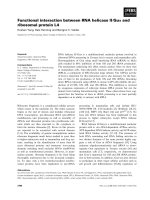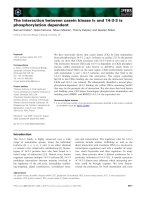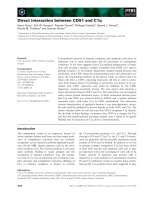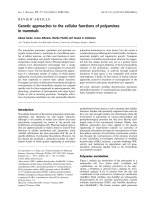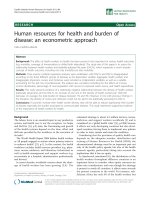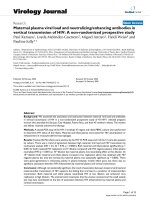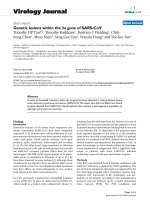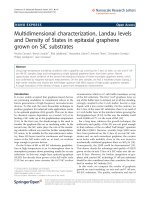Báo cáo sinh học: "Genetic interaction between sire and population of mates in Drosophila melanogaster" pps
Bạn đang xem bản rút gọn của tài liệu. Xem và tải ngay bản đầy đủ của tài liệu tại đây (507.52 KB, 9 trang )
Original
article
Genetic
interaction
between
sire
and
population
of
mates
in
Drosophila
melanogaster
CM
Wade*
JW
James
University
of
New
South
Wales,
Department
of
Wool
and
Animal
Science,
PO
Box
1,
Kensington,
NSW
2033,
Australia
(Received
8
May
1992;
accepted
3
January
1994)
Summary -
A
model
experiment
was
set
up
to
examine
the
level
of
genotype-environment
interaction
existing
between
a
sire
and
the
population
from which
its
mates
were
drawn.
The
character
considered
was
left
sternopleural
bristle
number
in
Drosophila
melanogaster.
A
total
of
128
males,
scored
for
the
trait,
were
mated
to
females
of
the
same
and
another
strain.
The
characteristic
was
then
measured
in
both
the
pure
and
crossbred
progeny
and
the
heritabilities
for
the
trait
in
each
group
were
determined.
The
genetic
correlation
between
pure
and
crossbred
performance
(t
standard
error)
estimated
from
covariances,
0.59
(!
0.17),
was
found
to
be
significantly
different
from
one,
indicating
the
presence
of
genetic
interaction.
The
heritability
of
purebred
performance
(by
regression
analysis)
was
found
to
be
0.29
and
the
heritability
of
crossbred
performance
0.11.
The
corresponding
average
values
from
sib
analysis
were
0.40
and
0.24,
respectively.
A
comparison
of
responses
from
different
selection
methods,
incorporating
the
estimated
parameters,
found
that
selection
on
the
basis
of
sire’s
own
performance
led
to
the
largest
improvement
in
the
performance
of
crossbred
progeny.
The
implications
of
the
results
are
discussed.
genotype-environment
interaction
/
genetic
correlation
between
purebred
and
cross-
bred
performance
/
sternopleural
bristles
/
Drosophila
melanogaster
Résumé -
Interaction
génétique
entre
géniteur
et
population
des
partenaires
chez
Drosophila
melanogaster.
Une
expérience
modèle
a
été
menée
pour
examiner
l’importance
de
l’interaction
entre
le
géniteur
et
la
population
dont
ses
partenaires
sont
issus.
Le
caractère
utilisé
est
le
nombre
de
soies
sternopleurales
sur
le
côté
gauche
chez
Drosophila
melanogaster.
Cent
vingt-huit
mâles,
contrôlés
pour
le
caractère,
ont
été
accouplés
à
des
femelles
de
la
souche
elle-même
et
d’une
autre
souche.
Les
héritabilités
ont
été
estimées
dans
les
2
souches.
La
corrélation
génétique
entre
les
caractères
en
souche
pure
et
en
croisement,
de
0,59
f
0,17,
était
significativement
différente
de
1,
indiquant
la
présence
d’une
interaction
génétique.
Les
héritabilités
du
nombre
de
soies
chez
les
souches
*
Present
address:
Department
of
Farm
Animal
Medicine
and
Production,
The
University
of
(aueensland,
Brisbane,
(aLD
4072,
Australia
pures
et
hybrides
sont
0,29
et
0,11
respectivement
par
régression
parent-descendant
et
les
valeurs
correspondantes
estimées
par
analyse
des
germains
sont
0,40
et
0,24.
Une
comparaison
des
réponses
prédites
selon
différentes
méthodes
de
sélection,
sur
la
base
des
paramètres
estimés,
montre
que
la
sélection
sur
la
performance
propre
du
géniteur
donne
l’amélioration
la
plus
grande
de
la
performance
dans
la
descendance
croisée.
interaction
génotype-milieu
/
corrélation
génétique
entre
performance
pure
et
croisée
/
soie
sternopleurale
/
Drosophila
melanogaster
INTRODUCTION
The
value
of
crossbreeding
to
increase
the
efficiency
of
production
has
been
recognised
in
many
animal
species.
The
improvement
of
production
in
the
crossbred
is
due
primarily
to
the
manifestation
of
heterosis,
or
hybrid
vigour,
which
indicates
the
presence
of
non-additive
gene
effects.
Standal
(1968)
suggests
that
if
heterosis
is
due
to
overdominance
then
selection
on
the
basis
of
purebred
performance
will
not
result
in
corresponding
improvement
in
the
crossbred.
Selection
on
the
basis of
crossbred
performance,
or
combining
ability,
is
complex.
In
practice
such
a
scheme
will
be
difficult
to
use,
particularly
when
populations
are
small.
If
the
degree
of
genetic
interaction
occurring
between
a
sire
and
the
population
of
females
to
which
it
is
mated
is
quantified,
then
the
choice
of
the
optimal
selection
method
is
facilitated.
It
is
possible
to
determine
the
extent
of
genetic
interaction
present
using
2
methods.
The
interaction
may
be
statistically
estimated
from
parameters
obtained
within
a
single
generation
(Brun,
1982),
as
in
this
case,
or
derived
from
estimates
of
variances
and
covariances
realised
in
the
course
of
selection
(Brun,
1984).
Brun
(1982)
defined
parameters
to
statistically
estimate
the
degree
of
genetic
interaction
for
the
particular
situation
of
genotype
by
mate
interaction
within
a
single
generation.
These
parameters
are
the
genetic
correlation
between
pure
and
crossbred
performances
(rgp
c)
and
the
relative
heritability
of
purebred
performance
(h
2)
compared
with
the
heritability
of
crossbred
performance
(h!).
The
parameters
renect
the
different
means
by
which
the
interaction
may
be
expressed:
in
one
case,
as
a
change
in
the
ranking
of
sires,
or
in
another,
as
a
difference
in
variance
between
the
purebred
and
crossbred
progeny.
Should
a
large
genetic
interaction
be
discovered,
then
selection
on
the
basis
of
crossbred
performance
will
result
in
greater
genetic
progress.
Should
the
interaction
be
absent,
or
insignificant,
then
selection
within
the
purebred
may
be
regarded
as
the
method
of
choice.
When
the
genetic
interaction
is
not
significant,
most
of
the
gene
effects
expressed
in
the
purebred
will
also
be
expressed
in
the
crossbred
progeny.
Selection
that
considers
only
performance
in
the
purebred
is
desirable
since
it
relies
only
on
individual
performance
rather
than
on
a
progeny
test
which
may
reduce
selection
intensity
and
increase
generation
interval.
In
this
study,
progeny
variances
were
analysed
to
estimate
genetic
parameters
including
the
genetic
correlations
between
pure
and
crossbred
performance,
cor-
relations
between
progeny
and
sire
performance,
and
the
relative
heritabilities
for
pure
and
crossbred
performance
for
left
sternopleural
bristle
number
in
Drosophila
melanogaster.
The
parameters
were
obtained
with
the
aim
of
elucidating
the
opti-
mal
method
of
selection
for
the
improvement
of
crossbred
progeny
performance.
MATERIALS
AND
METHODS
Two
random
breeding
strains
of
Drosophila
melanogaster
were
employed
as
source
and
tester
stocks.
The
source
stock
contributed
the
experimental
sires
and
the
dams
for
purebred
progeny,
and
the
tester
stock
provided
dams
for
crossbred
progeny.
The
source
stock
used
was
the
Hunter
Valley
wild-type
strain
and
the
tester
stock
a
white-eyed
mutant
strain.
Both
stocks
were
maintained
as
separate
random
mating
populations.
At
intervals
of
less
than
12
h
newly
emerged
flies
were
separated
into
sexes
for
each
strain
type.
Once
separated,
these
flies
were
transferred
to
fresh
bottles
containing
a
semolina-based
fly
medium.
Males
of
the
source
strain
were
chosen
at
random,
scored
for
left-sternopleural
bristle
number,
and
placed
in
separate
numbered
vials
with
4
females
each
of
their
own
and
the
tester
strain.
After
4
d
the
males
were
discarded
and
the
females
placed
in
pairs
of
similar
strain
into
laying
vials
labelled
with
the
sire
number
and
a
label
distinguishing
that
pair.
Prior
to
the
emergence
of
progeny,
females
were
removed
from
the
vials
and
discarded.
A
total
of
150
sires
were
measured
in
3
groups,
1
group
in
each
of
3
successive
months.
It
was
planned
to
score
left
sternopleural
bristle
number
in
10
progeny,
5
of
each
sex,
for
each
progeny
vial.
In
all
128
sires
were
included
in
the
analysis.
The
sire
components
of
variance
for
the
4
progeny
classes,
2
for
each
strain
and
2
for
each
sex,
were
calculated
using
a
hierarchical
analysis
of
variance
for
unbalanced
data.
The
model
was
adjusted
for
the
effects
of
group
(fixed),
sire
(random),
vial
(random)
and
random
error
according
to
the
model:
where:
Yij
kl
=
individual
bristle
score;
p
=
progeny
mean
for
each
sex
and
strain
type;
gi =
effect
of
the
ith
group;
si! =
effect
of
the
jth
sire
within
the
ith
group;
vz!k
=
effect
of
the
kth
vial
within
the
jth
sire
and
the
ith
group;
e2!kt
=
random
error
term.
By
analysing
the
data
separately
for
sexes,
the
presence
or
absence
of
sex
dimorphism
(Frankham,
1968)
could
be
established.
Progeny
class
regressions
were
analysed.
Coefficients
were
obtained
for
crossbred
on
purebred
performance,
within
and
between
sexes,
and
also
for
progeny
bristle
score
on
sire
bristle
score
according
to
the
model:
where:
Y
ij
=
progeny
mean
over
vials
for
the
jth
sire
of
the
ith
group
of
the
dependent
variable
(which
may
be
any
progeny
class);
p,
=
progeny
mean
for
each
strain
and
sex
type;
gi
=
effect
of
group ;
b
=
regression
gradient;
Xij
=
independent
variable,
which
may
be
sire
bristle
number,
purebred
male
bristle
number,
or
purebred
female
bristle
number;
x
=
mean
bristle
number
for
the
progeny
classes
compared;
e
ij
=
random
error
term.
The
regressions
were
used
to
determine
covariances
between
offspring
and
parent
for
each
progeny
class
and
for
purebred
and
crossbred
performance.
Variances
and
standard
errors
for
the
covariance
estimates
were
calculated.
Estimation
of
the
interaction
between
sire
and
population
of
mates
Heritabilities
Narrow-sense
heritabilities
were
determined
by
regression
analysis
with
the
heri-
tability
for
any
progeny
class
being
regarded
as
twice
the
progeny
on
sire
regression.
Half-sib
analysis
was
used
to
estimate
the
heritability
for
left
sternopleural
bristle
score
from
partitioned
components
of
variance,
such
that:
for
any
progeny
class.
Standard
errors
were
calculated
according
to
the
method
of
Falconer
(1983).
Genetic
correlation
between
pure
and
crossbred
performance
The
pooled
genetic
correlation
was
estimated
from
variances
and
covariances
pooled
over
crossbreds
(V,)
and
purebreds
(Vp),
and
between
pure
and
crossbreds
(cofp
c)
according
to
the
equation:
where:
rgp
c
is
the
pooled
genetic
correlation
between
pure
and
crossbred
performance;
Vp
=[<Tspm+!]/2;
Vc = [O’!cm + 0’!cf]/2;
i
cov
pc
=
!C0llgpmcm
+
CO’US
p
fcf
+
C0lJ
gp
fcm
’!
COf
Sc
fpmj/
4
;
0
O’!pf’
O’!pm’
O’!cf’
O’!cm
are
estimated
sire
components
of
variance
for
purebred
females,
purebred
males,
crossbred
females
and
crossbred
males,
respectively;
and
C0llgpmcm!
COV
Sp
fcf
,
COV
Sp
fcm
,
COVScf
pm
are
covariances
between
sire
components
for
the
same
progeny
classes.
The
variance
for
the
correlation
was
calculated
as
the
variance
of
a
ratio
(Kempthorne,
1957):
The
pooled
correlation
enabled
the
expected
level
of
interaction
between
the
2
breed
types
to
be
assessed
without
special
regard
to
sex.
Direct
and
correlated
selection
responses
for
increased
crossbred
performance
The
ratios
of
the
correlated
response
per
generation
to
individual
selection,
and
the
correlated
response
to
selection
on
purebred
progeny
performance
against
direct
selection
on
the
performance
of
crossbred
progeny
were
calculated.
CR;
=
correlated
response
in
crossbred
progeny
from
selection
on
sire;
CRp
=
correlated
response
in
crossbred
progeny
from
selection of
sires
on
purebred
progeny
test;
- R
e
=
direct
response
from
selection
of
sires
on
crossbred
progeny
test;
n
=
number
of
progeny
tested
per
sire;
il
=
standardised
selection
differential
for
individual
selection;
i2
=
standardised
selection
differential
for
progeny
tested
sires.
Comparisons
were
made
on
the
basis
of
selecting
50
sires
from
groups
of
1000,
2 000,
4 000,
10
000
and
20 000
individuals
tested.
If
sires
were
progeny
tested
then
fewer
sires
could
be
tested.
Selection
intensity
was
reduced
as
the
number
of
progeny
tested
per
sire
increased.
RESULTS
Partitioning
of
variance
components
Sire
components
for
purebred
progeny
were
approximately
double
those
for
cross-
bred
progeny.
Group
and
sire
effects
were
significant
in
all
progeny
classes.
The
vial
effects
were
insignificant
for
all
progeny
classes
(table
I).
Heritability
of left
sternopleural
bristle
score
The
heritability
for
left
sternopleural
bristle
number
in
the
crossbred
was
lower
than
that
for
the
same
character
in
the
purebred
(table
II).
This
difference
is
due
to
lower
sire
components
of
variance
for
crossbred
progeny
of
both
sexes.
The
heritabilities
calculated
for
crossbred
progeny
are
not
strictly
narrow
sense
heritabilities
since
differences
exist
in
levels
of
dominance
and
gene
frequencies
between
the
purebred
and
crossbred
populations.
Genetic
correlations
between
pure
and
crossbred
performance
The
pooled
estimate
for
the
genetic
correlation
between
pure
and
crossbred
(1)1
standard
error)
was
0.59
(!0.17)
(table
III).
The
estimate
differed
significantly
from
one
at
the
5%
level.
The
estimates
were
similar
for
all
sex-breed
combinations.
Estimated
response
ratios
Estimations
revealed
that
in
most
cases
individual
selection
of
the
sire’s
own
performance
gave
a
superior
response
in
the
progeny
to
direct
selection
on
crossbred
progeny
performance,
which
was
in
turn
superior
to
selection
on
the
basis
of
purebred
progeny
performance
(table
IV).
Differences
in
heritabilities
for
pure
and
crossbred
progeny
contributed
to
this
result,
as
did
the
reduction
in
possible
selection
intensity
with
progeny
testing,
offsetting
the
benefits
of
increased
selection
accuracy.
DISCUSSION
Genetic
interaction
between
sire
and
partner
population
has
been
found
to
occur
with
greater
frequency
in
traits
related
to
fitness
and
heterotic
traits,
which
usually
have
low
heritability,
than
in
traits
with
additive
gene
action
(Brun,
1985).
This
study
found
the
genetic
correlation
between
pure
and
crossbred
(!
standard
error)
to
be
significant
(0.59 t
0.17),
supporting
the
hypothesis
of
non-additivity.
Left
sternopleural
bristle
number
usually
behaves
in
an
additive
manner
and
ex-
hibits
little
or
no
heterosis.
It
was,
therefore,
surprising
to
find
that
the
heritability
for
the
trait
in
the
purebred
was
higher
than
that
in
the
crossbred.
Such
a
difference
is
often
an
indicator
of
non-additive
gene
action.
Estimates
of
heritability
for
bristle
number
in
Drosophila
melanogaster
are
wide,
ranging
from
0.14
(Sheridan
et
al,
1968)
to
0.46
(Howe
and
James,
1973).
The
estimate
of
heritability
from
regression
analysis
in
the
purebred
(0.29)
agrees
well
with
the
expected
heritability
of
0.2-0.3,
while
that
from
sib
analysis
was
somewhat
higher
than
expected
(0.40).
The
regression
analysis
estimate
for
the
crossbred
(0.11),
is
clearly
lower
than
was
to
be
expected
from
previous
studies
while
the
sib-analysis
estimate
(0.24)
was
in
the
expected
range.
No
estimate
for
genetic
interaction
between
sire
and
mates
has
been
previously
reported
for
sternopleural
bristle
number
in
Drosophila
using
the
statistical
ap-
proach.
Results
in
other
animals
and
traits
have
indicated
various
levels
for
rgp
c,
ranging
from
less
than
zero
to
greater
than
1.
The
few
values
for
laboratory
in-
sects
are
scattered
widely
(-0.32,
0.85
in
Brown
and
Bell
(1980)
for
eggs
laid
in
Drosophila
melanogaster,
and
0.4
for
pupal
weight
in
Tribolium
casteneum
(Wong
and
Boylan,
1970)).
The
comparison
of
responses
from
individual
selection
in
sires,
and
selection
on
the
basis
of
purebred
progeny,
and
crossbred
progeny
performances
when
testing
resources
are
limited,
revealed
that
under
the
observed
conditions
(rgp
c
=
0.59,
h)
=
0.29,
h!
=
0.11)
there
was
little
benefit
in
the
use
of
progeny
testing
as
an
aid
to
selection
for
increased
crossbred
performance.
With
limited
testing
capacity,
selection
on
individual
sire
performance
was
found
to
generate
superior
response
to
that
from
selection
on
the
basis of
crossbred
progeny
performance,
which
was
in
turn
superior
to
selection
on
the
performance
of
purebred
progeny.
This
was
primarily
due
to
the
higher
selection
intensity
possible
using
mass
selection,
and
to
a
reduced
dependence
on
sire
prolificacy.
The
accuracy
of
progeny
testing
is
increased
with
the
number
of
progeny
tested
per
sire.
However,
when
testing
capacity
is
limited,
increasing
the
number
of
progeny
tested
per
sire
decreases
the
number
of
sires
able
to
be
represented
in
the
test.
If
the
number
of
sires
required
is
fixed,
then
the
selection
intensity
is
decreased
as
the
number
of
progeny
per
sire
increases.
The
optimum
response
from
direct
selection
on
crossbred
progeny
performance
occurs
at
the
point
of
balance
between
effects
on
selection
accuracy
and
selection
intensity.
As
testing
capacity
is
increased,
the
response
from
direct
selection
on
crossbred
performance
increases
relative
to
the
response
from
individual
selection
due
to
increased
selection
accuracy.
Robertson
(1957)
showed
that
the
optimum
response
from
progeny
testing
was
achieved
when
the
number
of
progeny
(n)
tested
was:
where
k
describes
the
ratio
of
males
recorded
to
the
number
selected
and
h!
is
the
heritability
of
crossbred
performance.
The
comparison
of
purebred
and
crossbred
progeny
testing
to
improve
crossbred
performance
revealed
that
for
every
testing
capacity
and
family
size,
direct
selection
on
crossbred
performance
yielded
superior
responses
in
the
crossbred
to
those
resulting
from
selection
on
the
basis
of
purebred
progeny
performance,
a
direct
result
of
the
genetic
interaction
between
pure
and
crossbred
performance.
The
use
of
progeny
testing
to
evaluate
sires
for
crossbreeding
performance
in
livestock
is
disadvantaged
by
some
practical
considerations.
First,
it
is
necessary
for
the
breeder
to
maintain
both
source
and
tester
dam
populations
in
order
to
progeny
test
the
sires.
One
of
the
dam
populations
will
produce
stud
stock
(source),
and
the
other
commercial
stock
(tester).
Different
management
practices
may
be
required
for
the
2
types
of
stock.
Second,
there
is
a
loss
of
production
in
purebred
progeny
when
sires
are
selected
for
crossbreeding
merit
and
a
significant
genetic
interaction
is
present.
Finally,
the
selection
lag
occurring
as
a
result
of
progeny
testing
reduces
selection
response,
particularly
in
larger
species.
The
genetic
gains
able
to
be
made
through
direct
selection
on
crossbred
progeny
performance
are
unlikely
to
outweigh
these
disadvantages.
Harris
(1976)
suggests
that
the
optimal
selection
approach
is
to
select
on
an
index
of
sire
and
crossbred
progeny
performance.
An
alternative
approach
may
be
to
select
sires
for
progeny
testing
on
the
basis
of
their
own
performance
and
then
make
a
further
selection
on
the
performance
of
their
progeny,
or
on an
index
of
individual
and
progeny
performance
(Cochran,
1951).
In
this
case
crossbred
progeny
would
be
used
in
the
progeny
test.
Although
a
genetic
interaction
between
the
sire
and
population
of
mates
was
observed,
it
was
insufficiently
large
to
warrant
direct
selection
for
crossbred
progeny
performance.
This
was
demonstrated
by
the
comparison
of
responses
between
individual
selection
and
selection
on
the
performance
of
crossbred
progeny.
The
findings
suggest
that
for
both
genetic
and
economic
reasons,
selection
on
the
basis
of
individual
performance
is
the
best
selection
method
of
those
examined,
assuming
that
the
correlation
between
pure
and
crossbred
performance
is
a
positive
one.
REFERENCES
Brown
WP,
Bell
AE
(1980)
An
experimental
comparison
of
selection
alternatives
to
plateaued
response.
Genetics
94,
477-496
Brun
JM
(1982)
Interactions
g6niteur
x
population
des
partenaires.
I.
D6
finition
d’inticateurs.
Ann
Genet
Sel
Anim
14,
463-479
Brun
JM
(1984)
Interactions
g6niteur
x
population
des
partenaires.
II.
Detection
par
des
experiences
de
selection.
Genet
Sel
Evol 16,
455-465
Brun
JM
(1985)
Interactions
g6niteur
x
population
des
partenaires.
III.
Synth6se
bibliographique.
Genet
Sel
Evol 17,
561-578
Cochran
WG
(1951)
Improvement
by
means
of
selection.
Second
Berkeley
Sym-
posium
on
Mathematics
Statistics
and
probability
(J
Neyman
ed),
University
of
California
Press,
CA,
USA,
449-470
Falconer
DS
(1983)
Introduction
to
Quantitative
Genetics.
2nd
edition,
Longman
Group
Ltd,
London
(2nd
ed)
Frankham
R
(1968)
Sex
and
selection
for
a
quantitative
character
in
Drosophila.
II.
The
sex
dimorphism.
Aust
J
Biol
Sci
21,
1225-1237
Harris
DL
(1976)
Optimum
genetic
improvement
of
layer
productivity.
2.
Alterna-
tive
testing,
selection
and
mating
schemes.
Proc
25th
Ann
Nat
Poultry
Breeder’s
Round
Table,
6-7
May,
1976,
Kansas
City,
MO,
Poultry
Breeders
of
America,
Kansas
City,
MO,
USA
Howe
RR,
James
JW
(1973)
Response
to
selection
in
synthetic
lines
of
Drosophila
melanogaster.
Aust
J
Biol
,Sci
26,
613-623
Kempthorne
0
(1957)
An
Introduction
to
Genetic
Statistics.
Wiley,
New
York
Robertson
A
(1957)
Optimum
group
size
in
progeny
testing
and
family
selection.
Biometrics
13,
442-450
Sheridan
AK,
Frankham
R,
Jones
LP,
Rathie
KA,
Barker
JSF
(1968)
Partitioning
of
variance
and
estimation
of
genetic
parameters
for
various
bristle
characteristics
of
Drosophila
melanogaster.
Theor
Appl
Genet
38,
179-187
Standal
N
(1968)
Studies
on
breeding
and
selection
schemes
in
pigs.
I.
Selection
on
performance
of
purebred
versus
crossbred
progeny.
Acta
Agric
Scand
18,
222-232
Wong
WC,
Boylan
WJ
(1970)
Intrapopulation
selection
and
correlated
response
in
crossbreds
of
Tribolium
casteneum.
Genetics
64,
69-78

